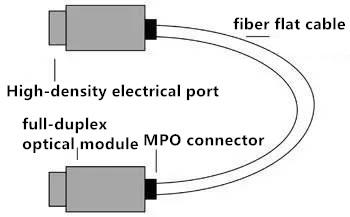- Related articles
- What Is GYTA Fiber Optic Cable?
- Applicable to 1000BASE-T Standard optical transceiver models
- All Cisco DS-X2-E10G-SR's information (List price, Specs, Datasheet PDF, Compatibility mat
- How to Change PCI-E Speed?
- All Cisco MA-SFP-10GB-SR's information (List price, Specs, Datasheet PDF, Compatibility ma
- Applicable to 10GBASE-LRL Standard Optical Transceiver Models
- What is IEEE 802.3?
- The Things You Need to Know about 10GBASE-EW Ethernet Standards
- The Things You Need to Know about 40GBASE-CR4 Ethernet Standards
- Optical Transceivers for Cisco SF302-08MPP-K9-EU Switch

In 2007, active cable (AOC) came out. As an alternative to next-generation data transmission, active fiber optic cable can transmit four fiber signals at the same time, while retaining the same electrical interface with the traditional cable, so that AOC technology can maintain signal integrity within 1 to 100 meters transmission distance.
Because the fiber has a lighter quality, better bending performance, bit error rate (BER) superior to that of copper cables, it is thus mass-produced, and first applied to the data center and server group, transmitting Ethernet and InfiniBand signal.
The composition of the active fiber optic cable
The active fiber optic cable consists of four main parts, one of which is a high-density electrical connector. As a joint, there are many forms of implementation, such as QSFP plus connector form and HDMI connector form. The former is mainly used for data centers and server groups, while the latter is mostly used for consumer electronics products. Another active cable component is multi-channel fiber flat cable for the length of 1 to 100 in which the single multi-mode fiber is universal. The third part is a full-duplex active optical cable module for photoelectric conversion. The fourth part is the MPO fiber optic connector that needs to be fixed in the active fiber optic cable housing to protect the inside fiber. The picture below shows a complete active fiber optic cable transmission system.

Two technologies for active fiber optic cable interface
The photoelectric conversion interface of the active fiber optic cable can be achieved by two technologies. The following will be a detailed description of two programs.
The first is to use silicon optical technology, also known as complementary metal oxide semiconductor (CMOS) process technology in which optical signals can be converted transmitted through electric current. Through the Edge Emitting Laser (EEL), it turns current into a light source to transmit the transmission signal. A photographic lens is used to transfer the photopolymerization with the wavelength of 1310 nm in the vicinity of the module. The EEL is made of a wafer material. It can transmit the signal to the component and outlet sides in parallel via a difference in the high refractive index between the air and the wafer material.
The second technique is a vertical cavity surface emitting laser (VCSEL). The technology uses a laser array to introduce the outer electrons into a thin area to simulate the quantum tunnel response and uses the coupled fiber to transmit the signal. The resulting current will be introduced into the high reflectivity reflector and the distributed Bragg reflector; which can fix the signal in the medium in a direction perpendicular to the surface, allowing the light to escape only to the surface via the wrapped circular beam output exit and forming a lower frequency reflection at the fiber wall.
Vertical resonant cavity emission type laser (VCSEL) has become the preferred solution because of its advantages of low cost, low power consumption, and high performance.
Advantages of active fiber optic cable
Compared with the traditional high-speed cable, active cable is particularly important in its transmission medium. The traditional copper transmission medium is copper, but the transmission medium of active fiber is fiber retaining the electrical interface connector. This makes that the active cable avoids electromagnetic interference problems in conventional cable transmissions and ensures a longer transmission distance than other media without sacrificing high-speed signal integrity. In addition, the active cable compared to the traditional copper cable is with the bit rate of BER 10E-15, which is not conductive and will not overheat. Therefore it is universal for a variety of terminal room ‘s transmission interfaces which wired networks reach to ensure data transmission security.
Conclusion
As the active cable contains huge business opportunities, more and more manufacturers have set foot in this area. In the future, with higher bandwidth demands, such as 4K video transmission, virtual reality, etc., higher bandwidth products based on the fiber are expected to be more and more widely available.





































































